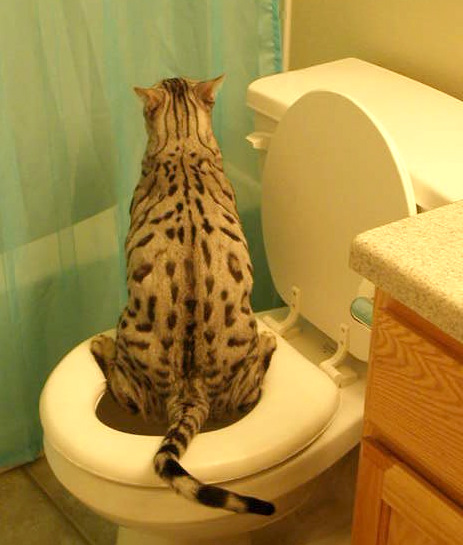Avoid Flush Cat Poop Down Your Toilet - Safeguard Your Plumbing Infrastructure
Avoid Flush Cat Poop Down Your Toilet - Safeguard Your Plumbing Infrastructure
Blog Article
We've noticed this post about Don’t flush cat feces down the toilet down the page on the web and accepted it made perfect sense to discuss it with you on this page.

Introduction
As cat owners, it's essential to bear in mind just how we take care of our feline pals' waste. While it might seem convenient to flush feline poop down the bathroom, this practice can have detrimental consequences for both the setting and human health and wellness.
Ecological Impact
Purging pet cat poop presents dangerous microorganisms and parasites right into the water system, posing a significant threat to marine environments. These contaminants can negatively influence aquatic life and compromise water high quality.
Health and wellness Risks
In addition to environmental issues, flushing cat waste can also pose health threats to human beings. Feline feces may contain Toxoplasma gondii, a parasite that can create toxoplasmosis-- a possibly severe illness, specifically for expecting women and people with weakened immune systems.
Alternatives to Flushing
The good news is, there are much safer and more liable ways to dispose of cat poop. Think about the adhering to choices:
1. Scoop and Dispose in Trash
The most common technique of getting rid of pet cat poop is to scoop it right into an eco-friendly bag and throw it in the trash. Make sure to use a committed litter inside story and throw away the waste without delay.
2. Use Biodegradable Litter
Select eco-friendly pet cat clutter made from products such as corn or wheat. These litters are environmentally friendly and can be safely taken care of in the garbage.
3. Hide in the Yard
If you have a yard, think about burying cat waste in an assigned area far from vegetable yards and water sources. Make sure to dig deep sufficient to avoid contamination of groundwater.
4. Install a Pet Waste Disposal System
Buy an animal waste disposal system specifically created for cat waste. These systems utilize enzymes to break down the waste, lowering odor and environmental influence.
Final thought
Responsible family pet ownership expands beyond giving food and sanctuary-- it also includes proper waste administration. By avoiding flushing feline poop down the commode and choosing different disposal methods, we can reduce our ecological impact and protect human health and wellness.
Why Can’t I Flush Cat Poop?
It Spreads a Parasite
Cats are frequently infected with a parasite called toxoplasma gondii. The parasite causes an infection called toxoplasmosis. It is usually harmless to cats. The parasite only uses cat poop as a host for its eggs. Otherwise, the cat’s immune system usually keeps the infection at low enough levels to maintain its own health. But it does not stop the develop of eggs. These eggs are tiny and surprisingly tough. They may survive for a year before they begin to grow. But that’s the problem.
Our wastewater system is not designed to deal with toxoplasmosis eggs. Instead, most eggs will flush from your toilet into sewers and wastewater management plants. After the sewage is treated for many other harmful things in it, it is typically released into local rivers, lakes, or oceans. Here, the toxoplasmosis eggs can find new hosts, including starfish, crabs, otters, and many other wildlife. For many, this is a significant risk to their health. Toxoplasmosis can also end up infecting water sources that are important for agriculture, which means our deer, pigs, and sheep can get infected too.
Is There Risk to Humans?
There can be a risk to human life from flushing cat poop down the toilet. If you do so, the parasites from your cat’s poop can end up in shellfish, game animals, or livestock. If this meat is then served raw or undercooked, the people who eat it can get sick.
In fact, according to the CDC, 40 million people in the United States are infected with toxoplasma gondii. They get it from exposure to infected seafood, or from some kind of cat poop contamination, like drinking from a stream that is contaminated or touching anything that has come into contact with cat poop. That includes just cleaning a cat litter box.
Most people who get infected with these parasites will not develop any symptoms. However, for pregnant women or for those with compromised immune systems, the parasite can cause severe health problems.
How to Handle Cat Poop
The best way to handle cat poop is actually to clean the box more often. The eggs that the parasite sheds will not become active until one to five days after the cat poops. That means that if you clean daily, you’re much less likely to come into direct contact with infectious eggs.
That said, always dispose of cat poop in the garbage and not down the toilet. Wash your hands before and after you clean the litter box, and bring the bag of poop right outside to your garbage bins.
https://trenchlesssolutionsusa.com/why-cant-i-flush-cat-poop/
We were made aware of that write-up on Don’t flush cat feces down the toilet through a good friend on a different blog. I beg you set aside a second to share this blog post if you enjoyed reading it. We thank you for reading our article about How to Dispose of Cat Poop and Litter Without Plastic Bags.
Go Deal Now Report this page